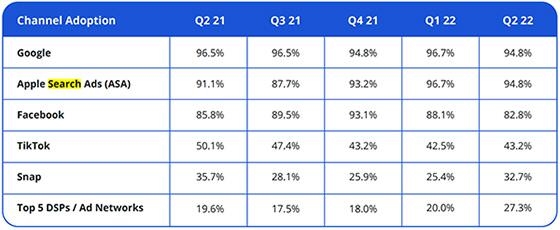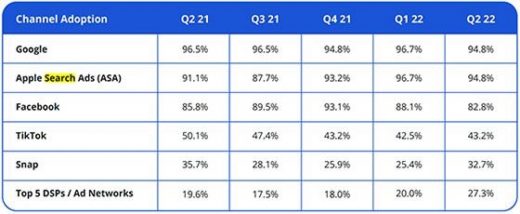Apple Search Ads Gain On Facebook, TikTok
Apple Search Ads Gain On Facebook, TikTok

Apple privacy measures boosted its search advertising business as a result of the company’s App Tracking Transparency (ATT) privacy initiative, while Facebook, Snap, and others experienced sharp declines in share of wallet and market share.
Appsumer, a performance insights platform for mobile app advertisers owned by InMobi, released a benchmark report Tuesday on how major advertisers leverage the top sources for app downloads, analyzed through advertiser channel adoption and share of wallet among top Self Attributing Networks (SANs).
Apple Search Ads share-of-wallet rose five percentage points, reaching 15%.
Apple’s first-party data advantage on iOS for both measurement and targeting has helped, but they will need more inventory, which is why rumors of an Apple demand-side platform (DSP) continue to rise, according to the Appsumer report.
Apple Search Ads joins Google and Meta at the top table of advertiser adoption — showing growth of nearly four percentage points to 94.8% — while Facebook adoption declined three percentage points to 82.8%.
Facebook has seen a YoY decline of 4 percentage points in its share of wallet, while SNAP lost 50% of its share. Both companies have been impacted by the current economic climate as well as by ATT.
While adoption of SNAP services declined three percentage points to 32.7%, it bounced back from 25.4% in the first quarter of 2022.
The research suggests Snap may recover its share of wallet in coming quarters, with adoption growth seen as a leading indicator.
TikTok now is positioned ahead of Snap in the share of wallet, if its audience expansion and advertising platform development continue to increase. Its advertiser adoption rate declined nearly seven percentage points to 43.2%. its share-of-wallet remained steady at 3% suggesting that some advertisers are succeeding, while others are struggling to come to grips with the platform.
Smaller advertisers continue to struggle with omnichannel advertising and marketing. They decreased the channels used on average by 1.1 year-over-year to 2.5. Large advertisers increased the channels used year-over-year (YoY) by an average of 1.4 to 10.7.
(8)


